Well, my first adventures with the deadlift were enlightening and a bit painful.
I was foolishly naive about the details of deadlifting form and just started into deadlifting without thinking too much about it. I only thought to keep my back in neutral position and then lift the weight. I started by trying the prescribed path in Underground Secrets to Faster Running by Barry Ross which suggests a series of weights to try in order to determine my maximum weights at certain repetitions. It starts at 50% of my body weight and works upwards from there, until you find your one rep max, or 1RM.
I got up to a rather wimpy 195 lbs for 2 reps and then trying 215 I could not budge it at all! This unfortunately strained my back, probably both muscles and my spine, for several days. I then had a session with my physical therapist who ran me through the intricate details of deadlifting form. In fact, around 155 lbs my upper back started to curl and my shoulders could not be kept in position as the weight dragged my upper body down. I should have realized this and not kept going.
I found out that deadlifting is more than what it seems. At first glance, it seems to be just a leg building exercise but it actually builds the entire upper body as well. You need to be able to activate a sequence of upper body muscles to not only lock the spine into neutral position but also to be able to perform the lift and get the weight off the ground and up into its final position.
I found out the hard way that I didn’t have the ability to activate my muscles in the right sequence, and also some of my muscles had “amnesia” which meant that my body had forgotten how to activate them when I needed their help in making the lift. This was a problem that had been plaguing me for my running – I know I have “gluteal amnesia” where my glutes would not fire and my hamstrings would get wiped out from running and ultimately cramp up during a race.
But first, the proper sequence, for the sumo version:
1. Take a wide stance, similar to the initial setup position of a sumo wrestler. The feet should be pointing about 45 degrees outward from center. Take as wide a stance as your flexibility allows; this will allow you to get the grip on the bar of the barbell as close to your body’s axis as possible, which allows the body to take the weight of the barbell with the spine as vertical as possible.
If you can, lift barefoot or in Vibram Five Fingers. Even the height of the sole can cause instability in the lift.
2. Push your shins up to the bar, touching it. You will want the feeling of scraping the bar up along the shins when you lift up, but also being that close to the bar means the weight is as close to your centerline as possible.
3. Squat down. The flexibility of the leg and hip muscles may prevent you from getting down really low into a low squat, but you want to get as low as you are able. Also, you may find that your muscles are not strong and/or activated enough to be able to lift weight from such a low starting position. You may need to start in a higher squatted position.
4. Hinge the hips such that your butt is sticking out and not curled underneath. If your butt is curled under your spine, that means your spine is not aligned near the bottom which is bad. Lots of bad pressure to your disks if not aligned!
5. Grip the bar. Use opposite grips with the hands, one with the palm facing inward and one with the palm facing outward. With the hands in opposite directions, you can actually lift more.
6. In preparation for the lift, do this:
a. Grip the bar firmly.
b. Load up to right before the lift by extending upward with the body, but maintaining a neutral spine.
c. In loading up, tighten up the core, the back muscles, and the shoulder muscles. This will lock up the body in position and prevent your back/spine from moving out of alignment which will increase the possibility of injury.
d. Grip the ground with your feet and press up to right before the lift, flexing the leg muscles and glutes.
e. Look up at about a 45 degree angle. This will help keep the body in alignment. Looking down could cause your body to curl.
Setting up for the lift is super important. You want to make sure your whole body is locked in for the ultimate effort to lift the weight off the ground.
7. Take a deep breath and hold it. Holding your breath during the lift will help get you maximum effort. Then, as if you’re going to force your feet/heels through the ground, press the weight up, rising up on your legs, while keeping your body locked from step 6 above.
8. When you reach full extension of your legs, expel your breath at the top of the lift. Pull your shoulders back slightly, and then shove your hips forward while flexing your glutes. This completes the lift.
9. While the books prescribe dropping the bar, this is nearly impossible in most consumer gyms. You have to be at a real muscle place like Gold’s Gym to be able to drop a heavy weight without people or the staff complaining, or even if the floor can take that much of a weight slamming down on it from knee height.
Instead, after expelling your breath, take another breath, lock your body into position and then slowly lower the bar with your legs back to the floor.
10. Repeat steps 1-9 until you finish your set.
Now I practice this with only 135 lbs. Over the last few sessions, I make sure I can do this absolutely right. It is an interesting muscle activation experience.
When I lift, I rehearse the sequence through my brain as it’s easy to just forget one of the steps if I move too quickly.
I must maintain control and flexing of a whole set of muscles during the lift. I find that if I lose concentration, I can lose the tightening of any set of muscles which lock my body into position. This is bad and can cause my back to be sore, or cause my disks to fire up other muscles like my hamstrings, glutes, or erectors (back muscles).
Early on, I could feel that certain muscles just weren’t firing at all, especially my glutes. I could tell because after the workout, my hamstrings were very tight. Now I also focus on flexing my glutes especially during the lift.
I also have to watch the floor. At the YMCA in NYC, the floor is a rubberized tile. But it is also slippery against the soles of my running shoes, which caused my left foot to slip outward during a lift – very dangerous. I finally just took off my running shoes and socks and lifted barefoot. My sweaty feet nicely gripped the otherwise slippery tiles.
I need to burn the entire steps 1-9 into my brain so that I do it all, in sequence, naturally and every time.
Once I get the steps into my nervous system, then and only then can I start increasing the weight I lift.
Other exercises that are helping:
1. Cable rows, pulling the weight with elbows low.
2. Using a functional trainer or similar (one of those things with weights and cables and adjustable big arms), I row low, pulling my elbows to my sides and then pull my arms downward for triceps extensions.
3. Single leg dumbbell deadlifts, great for glute activation.
4. Single leg supine hip raises, one leg at a time.
Such a simple looking move, but yet so complex! I look forward to advancing in my Russian strength building techniques, and hopefully my running as well.
NOTE: By the way, an amazing back book is this: Ultimate Back Fitness and Performance by Stuart McGill. It’s expensive but well worth the read.
Category Archives: Running
Deadlifting for Faster Running
The book, Four Hour Body by Tim Ferriss, brings me new insight all the time. After implementing the details on pre-running prep, I started into the chapter on increasing strength for better running. This led me to Underground Secrets to Faster Running by Barry Ross which further describes what to do.
It is a melding of strength training techniques pioneered by the Russians and it’s effect on running performance. It basically uses the deadlift as the primary method for increasing strength, but you don’t train to failure like I was taught way back when I was really into weightlifting.
So many misconceptions about how to weightlift and why we are doing it. I used to lift weights religiously on the hopes that I would increase muscle and size. I would train to failure and be into that “no pain, no gain” mentality. It would work for a while, but I would often plateau or I would injure myself. Reading the concepts in 4 Hour Body and then Underground Secrets to Faster Running, I finally understood how weightlifting can benefit running.
The idea is to gain strength without increasing your size. Bodybuilders want to look good on stage and on the beach, so they want to increase size and lose fat to increase definition. But that doesn’t necessarily make them strong. And often you gain weight while your muscle size increases. Training to failure can make you bigger, but it doesn’t necessarily make you stronger. It does increase your chance for injury as your support structures also fatigue during the last few reps.
But us runners want to remain light so that we’re not dragging around extra pounds during a race. That’s a waste! However, we can get strong without extra weight. With more strength, we can endure the energy sapping conditions of a race better. We can also increase our cycle rate as our legs/feet can rebound off the ground with more energy and do it longer without fatiguing.
I dug into this further in Power to the People by Pavel Tsatsouline. Really interesting concepts into how the Russians have trained for strength for the Olympics. But the focus of this training is more for maximal strength for powerlifting. I needed maximal strength that also didn’t leave me fatigued or wiped out for run training afterwards. This was also a problem with training to failure; it would leave me sore and tight on the next day that I could not run effectively.
The plan described in 4 Hour Body and Underground Secrets involved a combination of pressing motions and plyometrics. In this case, the two main movements would be the bench press and deadlift, with plyometrics. The plan called for 2 reps at 95% 1RM (1 Rep Maximum) and then 5 reps at 85% 1RM. This was both for bench press and deadlift. Then after each set, I would immediately do a set of plyometrics and hit my stopwatch to do nothing for 5 minutes of rest. The 5 minutes of rest was crucial for me to return to a nearly fully recovered state. This would enable me to gain strength by activating the right aspects of my muscles but not stimulate growth in size and weight. Also, given that I was almost fully recovered, my support structures would not be fatigued and thus I would be less prone to injury.
The typical workout would eventually look like this:
Warmup w/ dynamic stretching, not static
Bench Press
1 set 2x 95% 1RM weight
push up plyometrics (or 10 pushups)
rest 5 minutes
1 set 5x 85% 1RM weight
push up plyometrics (or 10 pushups)
rest 5 minutes
Deadlift
1 set 2x 95% 1RM weight
jumping plyometrics
rest 5 minutes
1 set 5x 85% 1RM weight
jumping plyometrics
rest 5 minutes
Other Exercises
Core Exercises
Cool down with static stretching
Note the addition of Other Exercises and Core Exercises to round out the workout.
Other Exercises I do are some combination of:
Reverse Hyperextension using exercise ball and bench
Glute Ham Raise, assisted
Hyperextensions
Supine Hip Raises
Single Leg, Stiff Legged Dumbbell Deadlift, with 1 or 2 dumbbells
For Core Exercises, I keep it simple and use what is suggested in 4 Hour Body which is the Torture Twist. You lay on a sideways bench and hook your feet under a bar or similar. Then lay back and turn to one side to hold for 3 seconds, then turn to the other side and hold for 3 seconds, then repeat for 3 times and then sit up for rest of 30 seconds. Do up to 3 Torture Twists, and then start increasing the hold time from 3 seconds to longer.
As I mentioned, I was into weightlifting back many years ago. However, I knew that I could not jump back into weightlifting without starting out slow. I had to start out slowly and see what my current limits were and build from there. Way back, I knew what my 1RM for bench press was and that was 215 lbs at a body weight of 150. Still, I was out of shape to attempt even close to that now. As for deadlift, I had no idea what my 1RM was at all.
The other complicating factor was that I had never deadlifted at all in the past. I had tried it a few times, but never worked on it. I had no idea how my core and back muscles would take heavy deadlifting.
For the upper body movement, I would just start with pushups for a few workout days and then add in plyometrics for chest, and then go to bench press with plyometrics. For deadlift, Underground Secrets gave a workout sequence for determining my 1RM and I thought I would give it a try. I picked the sumo style of deadlifting versus traditional as it would put my hips closer to the bar and hopefully not stress my back as much as the traditional form.
The workout sequence they gave was to start with some % of your body weight and deadlift for 3 times. Do the plyometrics, rest for 5 minutes after. Then increase weight and deadlift for 2 times and repeat plyometrics and rest. Then increase weight and deadlift for 1 times, repeating plyometrics and rest. The next workout day, you would start with more weight and repeat. Repeat this sequence over a period of many days until you fail on a lift attempt. This would be your 1RM.
I got up to about 155 lbs when I felt like my shoulders were starting to drag forward due to the weight. I had a feeling this would be a problem but I decided to keep going just to see what would happen. I got up to 195 lbs for 2 reps and totally failed at 215 lbs. But after the workout, my lower back was pretty sore since by then shoulders were totally dragging down and my back was beginning to round due to the load of the weight. This was bad!
One problem with all these programs is that they never talk about how to start out. They pre-suppose you having some level of fitness or ability beforehand. They just jump you into the workouts and don’t talk much about preparation, which could take months beforehand.
At least 4 Hour Body had a small chapter on pre-run preparation. I do those exercises religiously even though I’m not really starting out as I find they have benefits. The big problem with the strength training is that lifting heavy weights is kind of dangerous if you don’t know what you’re doing. This is why I started getting afraid when my shoulders started dragging downward and my back started to curl under the heavy weights, and I was right: a sore lower back was not a good thing.
Querying my sports medicine guy, he showed me proper deadlift form. Here is a great video on proper deadlifting form:
He also told me that a lot of it has to do with a super strong upper body and being able to lock it in position even under super heavy load. My upper body was totally unprepared for even a relatively wimpy 200 lbs or so which is not even 1.5x my body weight. I have to be able to pull my shoulders back and down and hold it there while I lift upwards. So proper form, and the strength to hold form, are crucial. I started rowing now to increase my upper back/lat strength for heavier lifting.
For a while I will still deadlift lower weights in/around my weight until I feel that my upper body is starting to get the knack of holding proper form. Then I will increase gradually.
The other thing I changed was the negative/downward motion of the lift. In both 4 Hour Body and Underground Secrets, they prescribe dropping the weight at the top of the lift. Well, the problem with this is that most gyms, especially consumer gyms, hate it when you drop heavy weights. The floors and weights aren’t rubberized enough and the other people are too wimpy to like the loud thumping noise of the weights dropping onto the floor. Only true muscle gyms like Gold’s or World Gym let you drop the weight like that.
I tried racking the weight on low hooks on a squat cage after lifting to max height which works after a fashion because you lift up and then you shuffle forward slightly to rack the weight. But I was unsure that if I could rack the weight if I was nearing my max weight lifted. I then tried adding the negative/lowering portion of the lift. This definitely put added stress on my legs (because I was more sore afterwards) but at least I could get through my sets faster.
So far, so good. My running times on the track are getting faster and it’s unclear whether or not a month of deadlifting was the cause of this speed increase, but I intend to experiment for the better part of this year as I await the lottery drawing to the NYC Marathon later this year.
LA Marathon 2011: Pictures of Hell
Actually this is not red hot hell but a frozen hell. Note the wet pavement; you can’t see the rain coming down on us in the pictures. You can also see that my shirt is soaked through – that ain’t sweat unfortunately! Temps in 50s, high winds, wet race clothes, hands and feet both numb after only 3-4 miles into the race:
 |
 |
Me running past Grumman’s Chinese Theater and on Rodeo Drive. Note the dude with no shirt on – he must have been freezing:
 |
 |
 |
 |
 |
 |
 |
 |
 |
 |
After long miles battling muscle cramps, I am resigned to walking…and getting more hypothermic:
 |
 |
 |
 |
Finally the finishing chute along Ocean Ave in Santa Monica. I fight my cramps to have a run-in finish:
 |
 |
 |
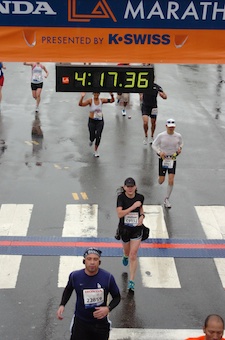 |
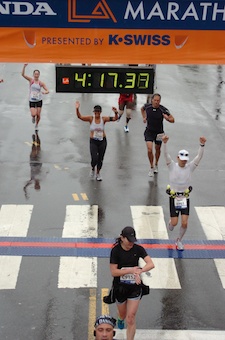 |
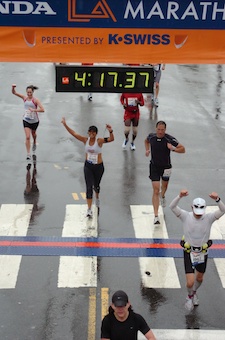 |
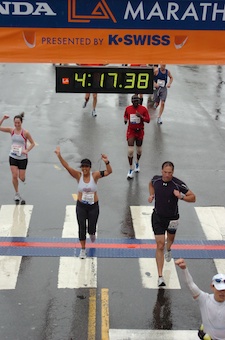 |
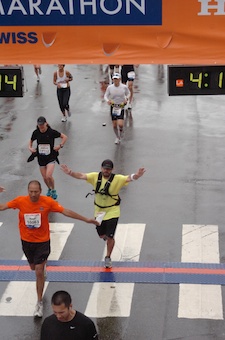 |
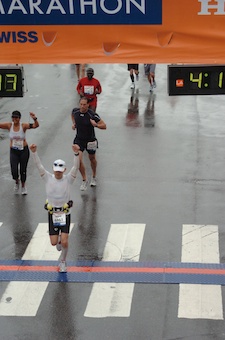 |
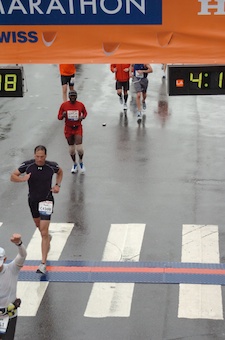 |
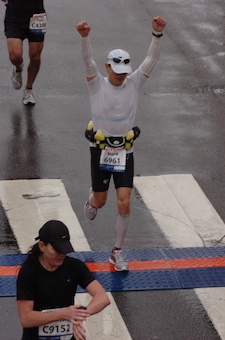 |
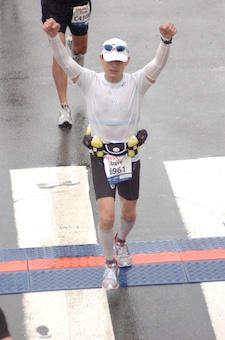 |
First, me happy to have finished! Then, me not so happy with the wind blowing my mylar blanket around and not keeping me warm at all:
 |
 |
Me turning off Runkeeper:

Body temperature dropping after the finish:
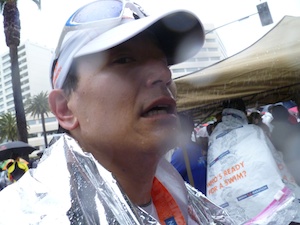
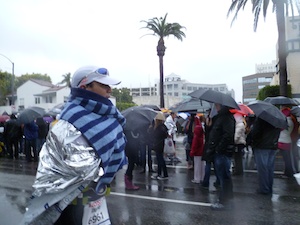
Teeth are chattering now, that isn’t a smile:
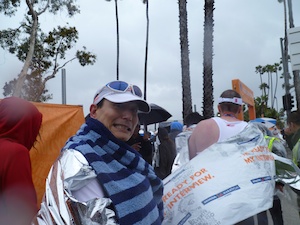
The lone tent under which 50+ people were huddled to escape the rain and wind:
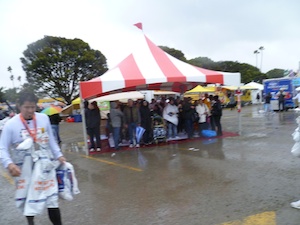
Finally a smile after I change out of my wet clothes and put on a wool shirt and rain jacket. Teeth still chattering behind my lips worse now:

Moving as quickly (and painfully) as possible to my car, which is at least a mile or two away SUCK:
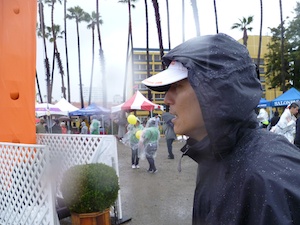
LA Marathon 2011 Post-Mortem and Recovery: 3-21-11
Recovery is going pretty well. I took about 70g of protein powder after the race, through many doses across the rest of the day. Today, race day + 1, I took an additional 80g of protein powder. Both days I drank several packets of Emergen-C to keep throwing vitamin-C and other essential vitamins into my body for recovery.
Currently, after the race, what hurts:
1. My left ankle, but after I adjusted it, the pain went away!
2. My left anterior tibialis is sore. Left ankle area on top is sore when I move/bend the foot.
3. My right anterior tibialis is not sore much. Right ankle area on top is sore when i move/bend the foot.
Re: 2 and 3 – I think that the numbness in feet due to cold contributed to this. I felt like I was running on club feet and could not tell how my feet were landing on the ground. This could mean that my foot contact was not optimal and beating up my ankles and the surrounding structures more than normal.
4. Almost no soreness in either hamstring or glutes. I think those 4 Hour Body exercises are working well!
5. Both quads very sore. I think this was exacerbated by the cramping in both quads. I suspect 3 things that caused the cramping:
a. It was a cold day and I was not drinking much, so less electrolyte contribution from my sports drink. I was gel-ing every 45 min. so that was still on my normal schedule. I had electrolyte tablets with me, but didn’t take them until mile 14 after my right quad cramped. By then it was too late. I should have started taking them on my usual schedule, but I was also curious to see if I really needed that much electrolytes, and especially on such a cold day.
b. The cold was driving down my heart rate. I looked at my HR graph from my Garmin 305, and it steadily declined as the day wore on. Some of that was due to my walking, but I could see my HR angling downward even before my first cramping at mile 14.

So I wonder about whether or not less blood flowing through my muscles caused the cramping since they were not getting enough nutrients or electrolytes. Need to look up research on the effect of cold on muscles and cramping.
c. I’m just not strong enough. After I recover, I’m going to start on some suggestions in the 4 Hour Body book from the coach who makes sure his athletes are super strong for running, using lots of deadlifts and similar exercises. I think I’m pretty weak in the quads, and especially if I’ve been working the hams/glutes with the weights/exercises I’ve been doing and they have practically no soreness at all.
5. My right shoulder/pec is very sore. It was getting sore towards the latter half of the race. I suspect that carrying my kid too much had something to do with that. It was taking a lot of my concentration to keep that shoulder/pec from tightening up as I ran.
6. I only slept 4 hours the night before. Every night before that, since daylight savings time started, I have not gotten really good nights of sleep at all. So a whole week of not sleeping enough may have left me at not maximum condition at start of the race.
Lots to think about and work on in the next upcoming months.
Analyzing Angles and Max/Min Height in Running
A buddy of mine sent me this video from the Somax Performance Institute in Tiburon, CA. It showcased some of their research on elite runners from Kenya and in the US:
They conclude that it’s not genetics but rather run form/mechanics that determine why Kenyas are consistently winning races versus US runners. It was very eye opening, but also firmed up a belief that I had that most of our own problems in running are not genetic, but rather problems in how crappy we run, and these problems are what get us injured and keep us from getting fast.
Immediately after seeing this video (and replaying it many times over and over again), I dug up some old running video taken last year of me running on the track last June 2010. I took frames out of that video and measured some key angles and my max/min height against those of the elites. Here are my results for 3 of the angles:
Max/Min height of when you run:

Mine was about 2″:
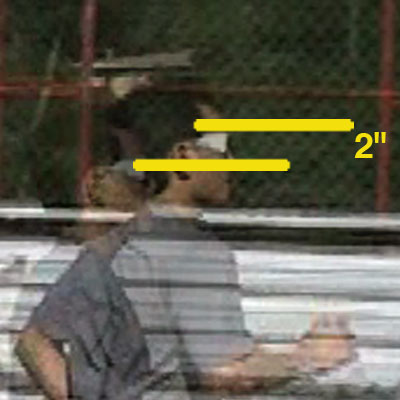
Stride Angle:

Here are mine on either side, note the difference:
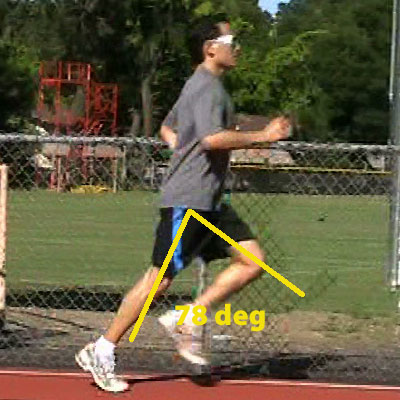
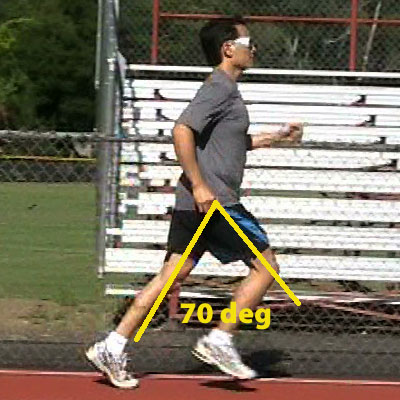
Toe Lift Angle:
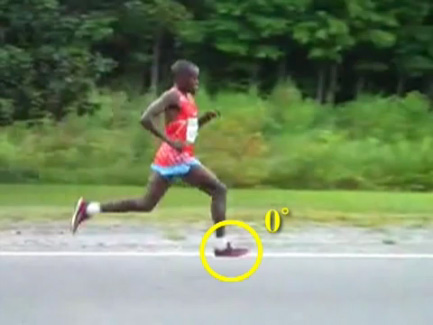
Here are mine on either side, note the difference:
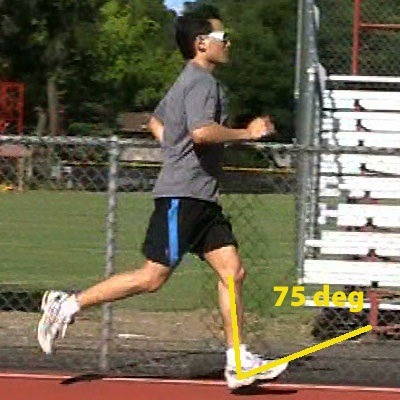
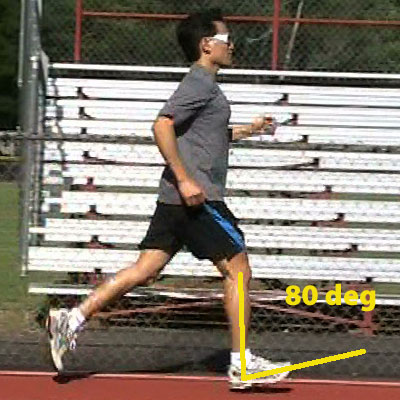
Toe Lift Angle:
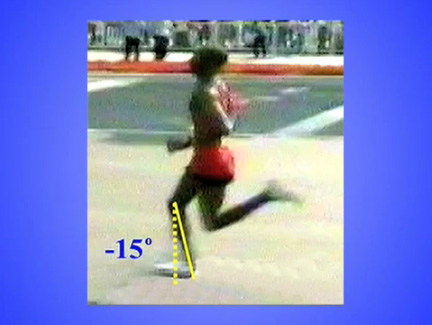
Here is mine on the right side:
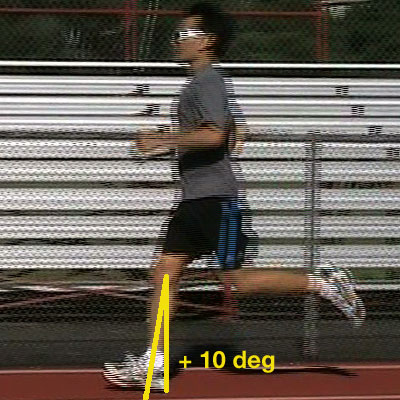
After I saw this, I knew I had a lot of work to do to get even close to the elites! I pinged my physical therapist and told him we had to get started on these angles ASAP!
In the next few weeks, I’m going to take 2 video cameras to the track and take some video of me running at different speeds. I hope to see an improvement since last June, but also I suspect the angles are different for every running speed.
LA Marathon Race Report 3-20-11: Misery Redefined
The LA Marathon for 2011 started very poorly. There was rain in the forecast for LA, but it hit SF first and 1/2 hour before my flight was supposed to take off, AA cancelled my flight due to weather, sunspots, whatever! I got on the phone with their special hotline but they told me everything was booked solid and I could arrive on Tuesday. Well, that works real well, don’t it? So they did give me a refund thankfully on Saturday’s leg BUT I was panicking on how to get down to LA in time to get to the expo at Dodger Stadium, which was closing at 5pm!
I literally ran over to the Southwest desk, at the end of the next building over, to see if they had something. There was a flight with space, but it was at 310p at Oakland airport! I took it on the chance that I could get to LA in time to get over to Dodger Stadium. It was supposed to arrive at 420p but I thought that the chance of me getting to LAX in time to get in a taxi and get over to Dodger Stadium before 5p was pretty slim if not even possible. But I have no other choice. I hop in a taxi and he huffs it to Oakland.
As I’m sitting in the taxi, I’m starting to panic. Thankfully I find someone in LA to go to pick up my race materials for me. I forward over my race confirmation email, a picture of my license which I amazingly had on my hard drive, and an authorization letter. I get on the Southwest flight and arrive at 430p which meant that I would have never gotten to the expo in time.
I arrive to cold and light drizzle. That was the first part of this miserable experience.
The next morning I got to the race start and it was relatively dry but very overcast. The wind had picked up but all of us were staying within Dodger Stadium to keep out of the cold and wind. I hoped that the weather would just stay overcast without rain. I was wrong.
The race started but it was a big blur due to the weather. Shortly after we start, the rain starts coming down. First it was a drizzle, and it was stopping and starting. I was doing OK, actually going pretty darn fast all things considering. It was probably a mistake to run at that speed though.
At mile 14, my right quad starts threatening to cramp. Up to that point, I had run through many instances of stopping and starting rain, with the rain getting more severe as the day went on, and the wind was picking up also. My hands and fingers were getting numb and I could barely open up my gel packets. I was running through rivers in the roads and my feet were getting numb from being cold and wet. I couldn’t tell how my feet were being placed on the ground; they felt like stumps.
My race clothes were getting totally wet and I knew that stopping would be a potentially fatal mistake. Wet clothing in cold weather will suck heat out of your body like nothing else. It could make me hypothermic. So I had to keep moving no matter what.
My quad doesn’t get better; it gets worse. I start walking when it seizes up until it calms down. I remember bringing some salt tablets and take those, but it helps not enough. This begins to repeat itself over and over again and I start slowing down considerably, especially when my left quad starts to do the same thing!
By mile 19, my quads were getting screwed and taking longer and longer to calm down. I start walking for longer periods of time until they calm down. By mile 21, I am only walking. And it’s raining hard. I start to shiver which is not a good thing. Thoughts of quitting enter my mind, even at mile 21 so close to the finish. I start looking for a medical tent to retreat to in order to quit. I ask around at aid stations where the heck is the next medical tent. They keep pointing down the marathon course. Wonderful. I’m walking, freezing my ass off, on the verge of going hyperthermic, and these guys tell me to keep going.
So I want to quit, but cannot quit. By this time, I start getting mad. I think about the crap I went through the day before. I think about my build to the Honolulu Marathon in December and couldn’t race because I sprained my ankle 3 weeks before. And even if I want to quit, I cannot!
At mile 22, I am at about Barrington and San Vincente which is near where a couple I know lives. As I pass through there, I start running because I don’t want my friends to see me walking. The things I do to maintain my tough guy illusion.
I get to mile 23 and see a medical tent there but keep walking. I get to mile 24 and figure out that if I walk for a 10 count, and then run for a 20 count, I can actually get my speed up. I reach the home stretch on Ocean Ave in Santa Monica and just start running to look good crossing the finish line. I cross at chip time of 4:15:00.
After crossing the line, I start shivering uncontrollably and I’m limping due to my quads being so tight. The wind at the beach on Ocean Ave is considerably greater than amongst the buildings. Now I’m walking and move quickly to grab a mylar blanket. But the wind is just whipping my blanket around. So it’s raining hard, the wind is dropping my body temperature, and I’m walking to my daughter and her mom who have come down in the raging rain to see me at the finish line. I finally find them and now I move/limp to where the expo is…and my race gear bag. After some miserable minutes, we get there and it’s a mess getting my race gear. The trucks are chaos and finally they find my bag. I move rapidly back to a tent where about 50 other people are huddled under in the whipping wind and rain. By now I can’t stop shivering. I take off my wet clothes and put on some dry stuff. Then it’s off to my car where I can barely grip my steering wheel because my hands are numb and get home to a hot shower where I finally can stop shivering.
Before this race, I thought that my most miserable race was Ironman CDA back in 2009. It, too, was a cold, drizzly day and after 12+ hours in that, it was sucked pretty bad. But after running in the whipping rain and wind in 40-50 degree weather, this has become my most miserable race. It’s too bad; the course is not bad and I’m sure in decent weather this is a great race. It’s easier than NYC Marathon and I think I can set my marathon PR here. But not when the weather is so cold and wet.
My new definition of misery is….LA Marathon 2011.
Analysis:
1. In thinking about what went wrong, I think my race prep was OK.
2. I think I went out too fast, even though I wanted to PR and didn’t feel all that bad.
3. Since it was very cold, I think my nutrition could have been better. I did not drink nearly as much fluid, limiting my intake of electrolytes and calories. I also decided to try not taking salt tablets which may have caused or enhanced my cramping.
4. I should have run with wool socks which would have helped even when wet. I also should have worn my gloves which could have helped my hands not be so numb.
5. Cramping hasn’t happened to me in a while. But I think I pushed too hard this race, too early. I think I will try some insight from Tim Ferriss’s Four Hour Body which was about how a coach first gets his athletes as strong as possible. I think that in general, I am not so strong and need to do this.
6. Maybe I should have just resigned myself to fate and not worked so hard to get to LA the day before and just not raced. Certainly I would have just sat here enjoying the warmth of my apartment while watching the wind and rain through my window.
But then I would have been disappointed to have done another training build to a race that I wasn’t able to run. That would have sucked.
All in all, I am glad I finished. It is said that Ironman elites have extreme mental toughness. I think that even though I felt miserable, I think that my fortitude in the face of overwhelming odds was trained significantly. I look forward to applying that in my next marathon.
Besides, I have to maintain the illusion of being an Ironman tough guy amongst my racing friends…
Running Off the Edge of the Cliff
Last week, I went out on the track to run a workout that combines 800s and 200s. The workout looked like this:
2×800 RI 1.5″
2×200 RI Jog 200
2×800 RI 1.5″
2×200 RI Jog 200
800 RI 1.5″
200 RI Jog 200
As I moved my way through the workout, I was recording lap times on my watch and feeling like my times were so dismal. In previous years, I had been able to run 800s and 200s so much faster than that morning, but for some reason I just could not make those speeds in recent weeks. I tried cycling my legs faster, but this just made me hit my aerobic limit that much faster and I risked flaming out before I could hit the end of an interval.
Then towards the last few intervals, I remembered that body positioning can enhance speed. If I lean too far back, I need to exert more energy in my legs to drive my body forward. Leaning forward by bending at the waist puts me off balance which is bad also, and I waste energy trying to maintain my balance. But leaning forward while upright, presenting chest, with shoulders slightly back and head upright as well, then gravity can add its acceleration to the body and create forward speed without expending muscle energy.
On every 200, I was running them at 43-45 seconds. Then on the 2nd to last 200, I decided to run it with more aggressive body lean forward. Unbelievably, I hit 41 seconds, and without addition of effort. I then ran the next 800 and it was faster than any preceding 800.
On the last 200, I maintained not only aggressive forward lean, but also cycled my legs a bit faster, pushing my aerobic capacity. I made it to 200 in only 39 seconds!!
But the whole time I was leaning my body forward in that upright manner, and leaning as far as I could, feeling like my upper body was pushing forward beyond my cycling legs, it felt like my body was sliding off my hips/legs and about to fall off a cliff the entire time I was running – what a weird sensation this was!
Now I will strive to maintain that “upper body is flying off a cliff” feeling during running, which I know is giving me free, effortless speed that requires minimal leg energy. It does give me an immense mental challenge, however; for some reason, focusing on keeping my body in that position is mentally taxing. With training, I know I can increase my mental endurance on maintaining optimal body lean over race distance.
High RPMs During Rest Intervals
Last year, my coach M2 gave me a set of cycling workouts which changed subtly; knowing that I had progressed many years with him, he knew he could increase their difficulty. The rest intervals now had a small but important change: they would be performed at 100RPM.
Now anyone who has tried to spin at 100 RPMs, even at low wattages, knows that it can be a heart rate raising experience. However, I had trained specifically for this. I had spent weekly sessions for years working on improving my ability to cycle at high RPMs. Given Lance Armstrong’s success at pedaling at high RPMs, I was determined to do the same. For recovery workouts, I use M2’s Pedaling Efficiency workout which is alternating one legged pedaling at 100 RPMs. It became a regular event every week and over a period of months, I could pedal at 100 RPMs through that workout with barely a rise in heart rate, certainly not approaching my lactate threshold heart rate at all.
Throwing 100 RPMs into the rest interval of 30 seconds to 1 minute in between high wattage intervals was scary, but I found that my neural muscular training with that Pedaling Efficiency workout really adapted my nervous system to perform even though the system was tiring. It also meant that in cases where I would raise my effort (ie. sprinting, or passing) that I would not collapse completely after that effort and my RPMs would drop after each of those effort. I could maintain RPMs, shift downward, and maintain my previous speed AND recover energy into my muscles. Before this, I would make the effort and then have to lower RPMs to recover or else my system would just keep rising in effort until I would flame out because I could not recover without the low RPMs. During a race this is really important.
Likewise, I started experimenting with high leg cycle rates in running. I would train weekly on the treadmill and do sessions of super high speed for short intervals. This trained my neuromuscular system to be used to high RPMs and to not easily collapse in the face of heavy or long efforts.
This has manifested itself mainly in hills. You hit the bottom of the hill and attempt to maintain speed up the hill. If the hill is long enough, you may find that by the time you get to the top of the hill you are so tired that you need to slow down your legs’ cycle rate in order to gain some rest. This is bad for your speed! As you crest the hill, you have nothing left to surge and accelerate again.
These days I practice relaxing completely BUT maintaining or increasing the cycle rate of my legs. I try to relax the muscles and rest them from the effort of the hill climb and then rest as I tell my legs to spin faster. It’s amazing that one can train for this; it really helps in not slowing down or collapsing entirely as you crest a hill and then move to the downhill on the other side where you want to keep higher RPMs to keep yourself moving down the hill. Thus, the rest interval happens during the crest and on the downhill.
I attribute this ability to high RPM training on the treadmill, using neuromuscular training intervals to train my nervous system to operate even in conditions of high effort. I also practice this when I’m out during a run through rolling hills; at every crest of a hill, I relax completely to rest but keep my legs’ cycle rate high, or try to even cycle them faster. I don’t want the nerves to stop firing when fatigued; I want to them to keep going even though my muscles are tired.
Again, the value of neuromuscular training is revealed. Whether on the bike or on the run, training your body to rest while maintaining high RPMs is a valuable tactic to being fast.
Barefoot Running
Earlier this year, I read Born to Run by Christopher McDougall and found it to be one of the most inspirational running books I’ve ever read.
One of the most important points the book makes is how our history of running in the modern world has been built up by a bunch of theories which were ultimately proven to be false, which also have been extended by a number of big corporations dedicated to creating running shoes. And all this can be prevented by going back to basics, which is to run barefoot.
But first, what has happened with our affinity for wearing shoes? In this great, detailed and very geek work, Shoes, Sitting, and Lower Body Dysfunctions | Eat. Move. Improve., it shows how we humans have completely atrophied or overstretched and weakened essential muscles which would allow us to run without injury. Not only have we done this simply by wearing shoes of all sorts, but our sedentary, sitting lives have also messed up our bodies quite a bit.
Mostly all these amazing support muscles nature has given us have just wasted away, making running a difficult activity when in fact it should not be.
Enter the barefoot running craze. After reading Born to Run, I went out immediately looking for my pair of Vibram Five Fingers. Anyone who has looked for a pair will note that it is near impossible to find a pair. They are so popular now that you can barely find them anywhere. So far, REI has some occasionally in stock, but if you’re down in Los Angeles area, Adventure 16 on Pico Blvd always seems to get a lot every week so check back frequently.
The fit is pretty particular so you need to go in and try them on. I was actually a size larger than the sizing chart recommended so you really have to make sure they fit right. Also, I first bought a pair of KSOs which were pretty good for cooler weather, like sub-60 degree temperatures. But the panel of fabric over the instep made getting them on not so easy. So I also bought a pair of Sprints which were much easier to get on, and I use them for the warm-enough days.
At the moment, I am up to walking around in them as much as I can. I have tried running very, very short distances just to see what it feel like. But I have not quite gotten there yet. I am training for the Honolulu Marathon right now and intend to race in my old dependable ASICS.
I am still a fan however. Many of my friends are starting out trying barefoot running and have asked me about it. So I thought I would post all the resources I’ve found so far on barefoot running. Here they are:
Born to Run by Christopher McDougall – the best inspirational running book I’ve read in a while, and big on barefoot running.
Shoes, Sitting, and Lower Body Dysfunctions | Eat. Move. Improve. – again, a very complete analysis of all the atrophy our bodies have undergone due to our shoes and sitting.
Running Times Magazine: Transitioning to Minimalism – a great short article on making the change to barefoot running, and a survey of the minimalist running shoes available now or soon.
12 Step Program to Run Barefoot – nicely setup step by step program to running fully barefoot that you can follow.
I found two books on Amazon that were specifically for barefoot running:
Barefoot Running: How to Run Light and Free by Getting in Touch with the Earth by Michael Sandler and Jessica Lee – I just ordered this one and will check it out.
The Barefoot Running Book: A Practical Guide to the Art and Science of Barefoot and Minimalist Shoe Running by Jason Robillard – I just got this on my Kindle and think it’s very concise and excellent.
I think these DVDs are excellent, and I generally like these better than books, which they also have:
Pose Method
ChiRunning
Evolution Running
All of these advocate forefoot running, which is the cornerstone of barefoot running. Forget that heel strike crap that anyone is feeding you. Heel striking just beats up your body.
Most people I talk to angst or whine about how they can’t change the way they run. I’m sorry but if you’re running wrong, you will end up injuring yourself eventually and then give up. So is it really that “you can’t” or “you won’t”?
Here are two really great books on getting people to realize that it takes a lot of focus, dedication, and hard work to burn new habits into your body:
This Year I Will…: How to Finally Change a Habit, Keep a Resolution, or Make a Dream Come True by M. J. Ryan – A great step by step and inspirational book to help you figure out how to change, and burn new and better habits into your lives.
Bounce: Mozart, Federer, Picasso, Beckham, and the Science of Success by Matthew Syed – some people think that all these talented people we see out there were born gifted; this book debunks that theory. Many of the things that we see others excel in were simply born out of THOUSANDS of hours of practice. It also means that if we put in the time and effort, we too can be really good at the things we want to be good at….like running injury free.
There you have it; all I can tell you about barefoot running. My hope is that someday I’ll get there, although I have short term goals which may mean that my barefoot running training is interspersed with running shod with normal running shoes. Suffice to say that it takes a long time to get there, and the time to adapt is highly dependent on your respective fitness, bodies, and muscles’ state.
My program is similar to the 12 Step Program; I will walk for many months. Then I will start jogging short distances and gradually lengthening them. I will watch my body’s response to the stress carefully and back off if something is tight or sore.
Already, I go to ART and Graston every week to help restore function to tight muscles. I also use Kinesio Tape and RockTape and the RockTape Taping Method to help the curative process as well as support my muscles during training. During my transition from crappy heel strike running to fore/mid-foot running, it took a lot of work with tape and my sports medicine docs to help me through that in one piece. Now I will go through that process again, going from shoe running to barefoot.
But hey, I’m going to be 45 this year and my body doesn’t have the ability to just adapt to new stresses overnight. They take a LOT OF TIME. I am patient, focused, and going as fast as my body allows.
Re-training my muscles is one aspect; re-training my nervous system is the other. Now I am focusing on precise foot placement as I run, putting each foot deliberately down as gently as possible, and trying to keep my feet gliding as low to the ground as possible. Doing this over and over again, and while I get fatigued, means that my nervous system must make this an unconscious habit. Only after hundreds, if not thousands of hours of training, can I burn this new habit into my body.
I am still early in this process and hope to post more about it as the months go by. Good luck in your own adventures with barefoot running!
Beginning Marathon Tips
Twice this year I was asked for some tips by some people running their first marathons. This is what I sent them:
1. It is important that you run 3-4 times a week. 2 is the barest minimum and may mean you will have a painful race.
A nice schedule is 3x a week with cross training in between, like cycling or swimming. If you can tolerate one more, then you can add that in.
2. Generally you run 2 shorter workouts and then have a long run.
3. If you are not running interval, hill, or threshold workouts for your 2 shorter workouts, i would advise you to gradually build from 30 min up to 1.25 hour running for your shorter runs. You will need to substitute longer endurance type workouts for the typical threshold workouts.
4. On the long runs, you should build weekly about 10% in miles. For me, i use time as a metric for training and increase my runs about 15 minutes every week.
5. When you peak for a marathon, you should do a minimum of 2, hopefully 3 at 20+ miles. If you can get to 22-24 miles it will be great training not only for endurance, but for mental training in how your brain deals with being out there so long. One 20+ miler is bare minimum.
6. You should consider a run-walk strategy for the race. I ran my first NYC marathon with a 5 min run :30 walk strategy and it got me in at 5 hours 19 minutes.
If you choose this, you should think about training this way also, so you can get used to running with walk breaks.
7. Somewhere between mile 14 and mile 20, most runners experience the “wall”. This is where your body seems to slow down and you’re feel like you’re moving through molasses, and its hard to go faster. You may experience a mental urge to just quit or slow down and just walk. This is the “wall”. During training, you should train within this mileage towards your peak to train your body and mind to deal with working through the “wall”. However, note that if you break through the wall, everyone typically experiences new found energy and you can run to the finish. So whatever you do, DON’T QUIT when you experience the wall. Keep moving!
8. You should practice hydration during your training runs.
you should consider getting one of these:
Fuel Belt Enduranace 4-Bottle Belt
and then get some bigger bottles:
Fuel Belt 10 oz Super Flask 2-pack
I typically go through 4 10 oz bottles of fluid during a race, for a 4 hour marathon. this varies greatly on temperatures. I have started drinking more from aid stations so nowadays I only take 2 10 oz bottles with me and just drink along the way.
Then you should get some extra pockets to hold your gels:
Fuel Belt Pockets
You should also pick a good sports drink to drink during the race. I use First Endurance EFS (http://www.trisports.com/1stendurancee3.html) because it has a lot of electrolytes and also some protein. But most importantly, it is whey protein as soy protein has been known to cause stomach problems. You can get EFS from Helen’s Cycles on Lincoln in Marina Del Rey. There is another store in Santa Monica. Or order it here at trisports.com
9. You should practice fueling during training. I am a big user of PowerGels because they have a higher electrolyte component, plus I can get some with caffeine for an added kick towards the end of a run race.
But caffeinated gels once threw my stomach into a churn and so I take it sparingly but like the extra kick it gives, but only take it during the last 1/3 of a marathon.
Other gels also work well. You just need to find what your stomach is OK with.
You’ll probably want to take one about 10 min before the race starts and wash it down with some fluid. Then you should take one gel every 45-60 min, and take a sip of fluid right after. You should start fueling as soon as the race starts.
Do not let your body get into a depleted state! You won’t be able to pull out of it. The body simply cannot work fast enough to replenish your energy stores. Generally, when you race, you’re burning more energy than you can take in and process. So it’s impossible to replace it all and don’t try. Just keep as much as you can going in with the gels and sports drink.
Your body is working hard to keep you going with your athletic activity and is not devoting much resources to digestion. Thus, training will help your body prepare for a long, hard effort but it cannot supply all the energy it needs. Gels and what you get in an energy drink are the easiest to absorb that do not require much from your stomach to do so. But even that has a limit to what it can absorb per hour. Taking more than that can mean some severe gastrointestinal problems, like vomiting, stomach ache, or diarrhea.
Trust me i’ve been there before and it is the worst feeling to have stomach problems during a race, besides the fact that squating on a port-a-potty is just gross anyways.
What’s even worse is to bonk. This is when you’ve sucked all the glycogen out of your muscles and you have nothing left, and you cant replace it either through fueling. It’s the worst feeling ever and you just feel like quitting. You may not even be able to run after you bonk.
10. Lubrication is a good thing to put on. You never know when you get chafing or blisters.
For chafing, i use Bodyglide. For my feet, i use Blistershield roll-on. see all of it here:
Lubricants
Pre-race and during training, rub bodyglide on inside of your upper arms and along your ribs and lats where your swinging arms will rub. Guys get nipple burn but I usually don’t hear women getting it, but I rub it on my nipples. I usually only put on lube for training runs longer than about 1.25 hours. Below that, it usually isn’t a problem.
I wear these socks to prevent blisters:
WrightSock
But i have found that my form is more predictive of blisters than socks. So in changing/correcting my footstrike to the ground, I have found that I have substantially reduced the chance of blisters, in addition to using Blistershield lube.
11. Another thing you may experience is sore biceps. This is from simply holding your arms up for such a long time. So watch out for this when you train and get used to holding your arms up that long. Learn to relax the whole way and shake out your arms occasionally.
12. Marathon taper is typically about two weeks. You do one more long run/high volume week two weeks before the race and then take two weeks to taper. I would not advise you to do a long run one week before. Experienced athletes are ok with this, but for beginners it’s better that you not overtrain, and that you arrive fresh and uninjured on race day.
13. I gave you some DVDs. i think the Pose Method stuff is a bit hokey, but definitely practicing balance by standing on one leg is a good thing. Running on the balls of my feet have eliminated knee problems although it took literally years for my calves to adapt to the stress. Only recently have they not protested in the early season after coming off the off season. ChiRunning is pretty good. Evolution Running was additive although I felt that I learned the most from ChiRunning and Pose.
14. As we mentioned, running into a headwind stinks. Try to find somebody to run behind. You are basically drafting behind.
15. Interval training is great. It allows you to create situations where you can adapt to higher stresses, which equate to handling tough conditions during races. But it is done with short bursts as training at super high intensities for too long, over too long a period of time will only lead to injury and overtraining. So here is one interval sequence that involves neuromuscular training. You should strive to do this sequence every week if possible.
———————————————————————————
Neuromuscular training
Description: use of super short intervals, with full recovery in between, but at super high intensity, will train your neuromuscular system to adapt to high efforts, whether they are high speed or high effort or both. Then slower speeds or lower effort will feel almost easy. But most importantly, it trains your neuromuscular system to fire neurons (to make the muscles move) faster and not to tire from simply the effort of firing. This is a source of fatigue and is easily eliminated by workouts like these. These are best done on a treadmill where the relentless nature of the treadmill forces you to keep up or else you’ll fly off the back (but please don’t!). The treadmill can also be cranked up to speeds that one would normally not be able to achieve, but eventually can adapt to. This will lead to faster speeds overall which may be hard to get to if only doing road or track work.
WORKOUT 1: Discover your workout speed or workout effort
Warm up with this sequence:
4 min easy jog, whatever speed works. For me that is 4 MPH.
Then, do this cycle with each time increasing the speed by .5 MPH:
30 sec @ Speed, then 30 sec rest back to your jog speed.
Keep increasing the speed until you find that it is almost too hard to keep up, but not so hard that you cannot. You may find that you will pass the speed you should be working out at where you will find it took everything you had to just hold on for 30 seconds, which is OK, so make your workout speed .5 MPH less than that number.
Once you find that speed, then if you don’t feel too tired, run another 2 intervals at that speed:
:30 @ X MPH, then rest for 1:00 in between intervals.
WORKOUTS AFTER 1: increase the number of times you can repeat speed X for :30, with rest interval of 1:00
Warm up again, 4 min easy jog, then do 30 sec @ speed with 30 sec rest. Increase speed by .5 MPH each time until you hit X MPH. Then take a 1.5 min easy jog.
Start with 4 repeats at :30 @ X MPH, with rest interval of 1:00
Then each workout time afterwards, try to increase by one more repeat. So next workout 5 repeats at :30 @ X MPH, with rest interval of 1:00, then 6 x :30 @ X MPH, RI 1:00, then 7 x :30 @ X MPH, RI 1:00, etc. If you cannot add one more repeat, then just stop at the previous number of repeats.
Total time for these workouts is less than 20 min usually.
———————————————————————————
16. The typical marathon before and race day looks like this for me:
Day before:
No training. Check into the race, get your race materials. Make sure you have enough supplies: Clothes, shoes, sports drinks, gels, etc. I also like to buy whatever it is I’m going to eat tomorrow morning.
Prepare everything you’re going to race with on the floor. I put my running shoes, hat, sunglasses, shirt, tights or pants, socks, etc. all on the floor and lay it out. I stick gels in my fuel belt. I pin my race number to my shirt or use a race number belt.
That night I eat a big pasta dinner. There is some evidence that you should eat a pasta dinner 2 nights before. I personally like to do both if possible. I think just the night before is probably enough. If it’s going to be a warm day, i may also toss salt on the pasta to help with electrolyte loading.
Then i go sit on the toilet and try to crap as much out as possible. I know this sounds bad, but you don’t want to go and crap out on the race course. It’s the worst feeling.
Morning of Race:
I like to get up about 3 hours before race start. As soon as i get up, I start eating my breakfast and get dressed. My typical breakfast is a hard boiled egg and maybe 1/4 of a bagel, plus a glass of sports recovery drink. This is to carbo load one last time before the race but with something that doesn’t upset my stomach. As soon as I finish eating, I go sit on the toilet and try to crap one more time.
I usually try to wear something warm as mornings can be cool depending on where you race. I bring a small pack with me to stuff everything in. Sometimes races will give you a plastic bag. In any case, whatever you bring you should mark it with your name and race number. I also bring a small plastic bottle of water with me, and one gel.
Then I get down to race start. For a marathon, there is usually a truck where you can hand in your backpack or bag of stuff. Thus you can arrive with warm clothes and then take them off and put them in a bag or pack and hand it to the truck guy. The truck then carries all the racer’s bags/packs to the finish line where you can pick it up. I stretch and warmup about 30 min before race start. I will run some light short reps back and forth to get my blood going. About 10 min before race i take the gel and sip some water. I try not to drink too much water or else i have to go to the bathroom.
17. Recovery is so important. It’s probably the least understood aspect of training. You need to rest your body and brain enough so that you can recover and grow for your next workout. Thus, triathletes are in a constant state of body breakdown and it takes time to adapt to daily stress over a period of 6 straight days of workouts, including double workouts (or triple) on some days. Most people don’t rest enough and this can cause dwindling performance and lead to injury and overtraining.
I think you should run 3 days per week with rest days in between, or recovery workouts in between. By recovery workout, i mean you can pedal on a bike or Lifecycle gently for about 20-30 min to help flush out bad stuff in your muscles and bring new nutrients in. Swimming is also a good recovery workout if you don’t swim hard. Also, I think you should not run the day after your long run. I think you’ll reach a mileage that you’ll find you’re fairly sore the day after. So take the day off!
You know I’m a fan of ice baths so they help remove soreness, help flush out bad stuff, and get new nutrients into muscles. Since you’re right by the beach, you could probably even just walk into the surf up to your upper thighs for about 10 minutes, since the surf is pretty cold.
Also, if you find that you are still very sore on the day after your rest day, take the day off also. Do not be afraid to take an extra day!
During the long training periods of ironman for me, I take one full day off, then the next day i can only do a recovery run and swim. Then on the second day after, I usually do a bike recovery workout. It’s only on the third day that I am back to being able to do a full effort workout. Before that it’s impossible. So I just accept that fact and rest that long. If I don’t, I could get injured and definitely would be pushing my body beyond what it is capable of absorbing at that moment. There was a time when I was pushing very hard and recovery even spilled into the third day and it was on the fourth day that I could finally do a full effort workout. It was only when I discovered protein powder that it almost brought my recovery back by a whopping full 2 days!
18. Eating is important. Your body needs calories to perform. It will not be able to do so on what you have stored in your body right now. That is because 1) the fat that is stored in your body is not easily accessible to heavy activity, and 2) your body has not stored enough glycogen in the muscles because you haven’t trained enough yet, and 3) your body has not yet developed the ability to convert the fat in your body to glycogen. So you should eat afterwards both in protein (to repair the muscle damage sustained in training) and carbs (to be stored in your muscles for use in the next day’s of training). You should try to eat within 1-2 hours after workouts to make sure you get enough. Otherwise, the body will start to cannibalize muscle tissue to recover, and you will feel drained because the body is attempting to restore glycogen in muscles but now is sucking it dry and attempting to do so by a much slower process of using other sources such as fat and protein. In fact it is so slow that you will not be recovered by the next day or perhaps even the day after! So eat right after each workout, even if it is a piece of fruit or smoothie for shorter workouts. For a long workout, I would definitely look at eating a larger meal to get protein and carbs back into your body.
Whew!! That’s a lot of information to digest! So many things to think about preparing for the race and then during the race itself! It can feel overwhelming but after a while it all comes pretty natural.
Here is a typical marathon build in Google docs. The dates correspond to this year’s Honolulu Marathon. Note that this employs a 3 week build, followed by a 1 week recovery week to give your body a break before beginning another 3 weeks of building running time.
If you’re reading this and you’re a first time marathoner, hopefully you’ll find this info useful. If you have any questions/comments/concerns, feel free to comment!